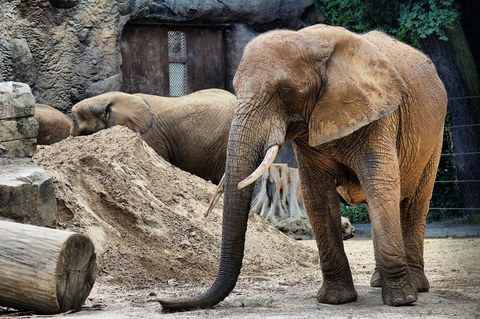Apr 02, 2024
Animals and Money: The Economic Importance of Sawu The Elephant for Dresden Zoo

Economically speaking a bad idea but nonetheless very important for conservation efforts, education and research: keeping elephants in the Dresden Zoo.
In Germany, zoos are incredibly popular, providing fun and education for people of all ages. While guests are expected to pay entrance fees, there are still many expenses and labor involved in caring for the animals. So the question arises: Is it actually profitable to maintain a zoo? To investigate this question, I will assess the economic importance of Sawu, the matriarch of the elephant herd at Dresden Zoo. She was born in the wild and has lived in Dresden since 1999, directly contributing to the earnings of this Zoo. To determine her individual value we have to look at the earnings and expenses of the Zoo. In 2019, Dresden Zoo had 884,270 visitors. Their entrance fees summed up to 3,534,606 €1. The elephant enclosure is 4837 m2 2 and I added an estimated 1500 m2 provided by the site plan2 to include the space for the zookeepers and visitor space such as walkways and safety zones. The resulting space sums up to 6337 m2, or 4.87 % of the total zoo area1. As three other elephants besides Sawu lived in that same area, Sawu’s share was about 1.22 % of the total zoo space. If I assume that Sawu contributes an income that is proportional to the space she occupies, Sawu’s contribution to the earnings were 45,066 € in 2019.
But what are the costs of housing Sawu? The elephant house was built in 1999 and renovated from 2015 to 2018 for 8.62 million €. In 2021, the outdoor enclosure was expanded for 750,000 €2, 3. With an estimated duration of 25 years this equals 374,800 € per year for housing, or 93,700 € per year just for Sawu. She is fed mostly hay, 150 kg per day3 amounting to 54.75 tons per year. With a price of 130 € per ton4, 7,117.5 € per year are spent on Sawu’s food. Dresden Zoo employs five elephant keepers3, 1.25 per elephant. They are employed at payment level TV-L 6, an estimated 2843.94 € per month (Level 3) in 20195. Social insurance contributions increase this amount to 3445 €, or 52,274.1 € annually. All these expenses sum up to 153,091.6 € per year to take care of Sawu. In comparison to her earnings of 45,066 € this shows that the Zoo looses 100,000 € per year just for Sawu. It is quite clear that there is no financial gain for keeping her, and the economics are likely similar for other animals. Because of this, the Zoo in general cannot finance itself and relies on subsidies from the city council, which amounted to 2,295,000 € in 20191. While the Dresden Zoo may not be profitable, it still contributes to the economy, providing over 100 jobs3 and additional ones due to construction projects.
It is important to know that beyond any economic considerations, Sawu contributes to Dresden Zoo as a place for education and species conservation. In terms of conservation, she is especially valuable. As she was caught from the wild her genes are not widespread within the population of zoo elephants. With the entrance fee, visitors can voluntarily pay the “Conservation-Euro” which contributes to a fund that supports several different conservation projects. One project, for example, is the Big Life Foundation for wildlife conservation in east Africa and benefits wild elephants1. Sawu is also valuable for research. Due to her excellent training, it is possible to take biological samples, such as saliva, that would be otherwise extremely difficult to collect in the wild6. Zoos in general offer opportunities for research that would not be possible otherwise.
In the end, it seems there is no economical reason for keeping Sawu at the Dresden Zoo or even keeping the zoo open itself. So why keep it open? Many believe keeping animals in zoos is immoral and unnecessary. Some say zoos in general offer opportunities for research that would not be possible otherwise. It could be argued that their contribution to research, conservation and education goes beyond financial value.
1 – Zoo Dresden, Jahresbericht 2019. 2020.
2 – T. Brockmann, “Der Umbau des Afrikahauses im Zoo Dresden – Zusammenfassung und Erfahrungen innerhalb einer 3-Jahres-
Retrospektive,” Zool. Garten, no. 89, pp. 67-92, 2021. Online version not available
3 – personal correspondence
Jana Skrobanek
